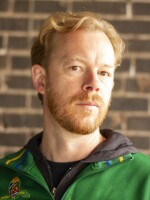For nearly three decades at the Wichita Eagle, Fernando Salazar shot photos that captured the day’s news. Five years after leaving the paper, Salazar has a new focus: using his camera to express himself. Torin Andersen has more for this month’s ArtWorks.
This interview has been edited for length and clarity.
“I wasn't working anymore," Salazaar says. "It was…just take the camera. Makes me look harder, makes me pay attention. Be here now.”
“A lot of times I'd be driving, and, well, I think there was something there, drive around the block, get out of the car, look around, check the angles. But usually, it's just quick inspiration when it hits me. It's like, I just see something and you always have your phone with ya, so that, now there's no excuse.”
Salazar now enjoys being more present with his camera. Photographing for the paper was his job for 25 years at the Wichita Eagle.
“I used to see the stuff before when I worked for the paper, but I didn't stop because it wasn't like it could have been used at the paper," he says. "You know, we always had to have a person in the picture, doing something. Now it could just be a landscape. Now it could just be a beautiful sunset.“
While working at the paper Salazar didn’t have to look far for work inspiration.
“As far as photojournalism goes, I don't think anybody beats Wichita’s Eugene Smith, and I find it weird that I ended up here, not living too far from where his house is here on North River Boulevard.“

Now Salazar is broadening his inspirational outlook.
“Maybe I'm just watching a lot of other photographers work these days, which I didn't do a lot when I worked at the paper. Seemed like I didn't have the time for it. But now I have the time for it.”
Photography is often seen as a moment and not a mood. Salazar feels differently now.
“Shoot what you feel. Not what you see. Exactly.”
“I started liking abstract photography," Salazar says. "I just shot that like coming out of my driveway.”
Salazar shows me an image on his camera. A jumbled mess of dingy and glistening brown flash across the screen. On closer inspection, a pile of wet and rotting leaves are revealed.
“Just the patterns of the leaves. You know, I think it could be cool, right?”
Salazar feels a lot of his images are realized through editing after the camera captures the raw image.
“You go back to it a couple of days later, or months later, you'll probably edit that picture completely different.”
Salazar defends his editing technique by expressing that world famous landscape photographer, Ansel Adams, already has an image in mind before snapping his shutter.
“So he sees the image already done before - before he even takes the picture. So he knows what he wants to get out of it.”
And like Adams, Salazar keeps returning to his preferred natural location.
“That one river that I love that I love going to that Nims Street Bridge over there," he says. "And the sunsets I captured from that, you know, with the little island there, in the sunsets I've captured from that little bridge, have just been amazing. Like pick my favorite spots around here.”



